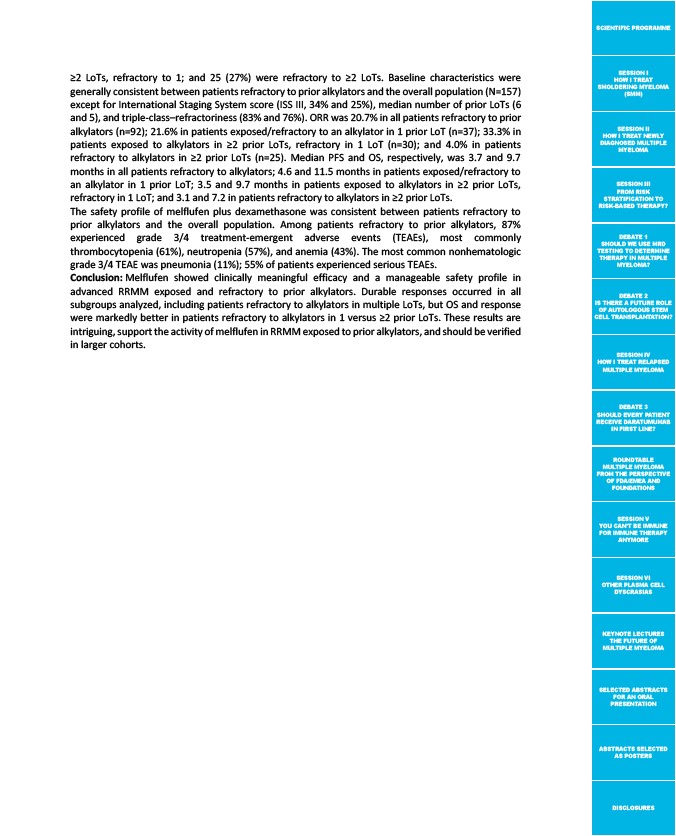
SCIENTIFIC PROGRAMME
SESSION I
HOW I TREAT
SMOLDERING MYELOMA
(SMM)
SESSION II
HOW I TREAT NEWLY
DIAGNOSED MULTIPLE
MYELOMA
SESSION III
FROM RISK
STRATIFICATION TO
RISK-BASED THERAPY?
DEBATE 1
SHOULD WE USE MRD
TESTING TO DETERMINE
THERAPY IN MULTIPLE
MYELOMA?
DEBATE 2
IS THERE A FUTURE ROLE
OF AUTOLOGOUS STEM
CELL TRANSPLANTATION?
SESSION IV
HOW I TREAT RELAPSED
MULTIPLE MYELOMA
DEBATE 3
SHOULD EVERY PATIENT
RECEIVE DARATUMUMAB
IN FIRST LINE?
ROUNDTABLE
MULTIPLE MYELOMA
FROM THE PERSPECTIVE
OF FDA/EMEA AND
FOUNDATIONS
SESSION V
YOU CAN’T BE IMMUNE
FOR IMMUNE THERAPY
ANYMORE
SESSION VI
OTHER PLASMA CELL
DYSCRASIAS
KEYNOTE LECTURES
THE FUTURE OF
MULTIPLE MYELOMA
SELECTED ABSTRACTS
FOR AN ORAL
PRESENTATION
ABSTRACTS SELECTED
AS POSTERS
DISCLOSURES
≥2 LoTs, refractory to 1; and 25 (27%) were refractory to ≥2 LoTs. Baseline characteristics were
generally consistent between patients refractory to prior alkylators and the overall population (N=157)
except for International Staging System score (ISS III, 34% and 25%), median number of prior LoTs (6
and 5), and triple-class–refractoriness (83% and 76%). ORR was 20.7% in all patients refractory to prior
alkylators (n=92); 21.6% in patients exposed/refractory to an alkylator in 1 prior LoT (n=37); 33.3% in
patients exposed to alkylators in ≥2 prior LoTs, refractory in 1 LoT (n=30); and 4.0% in patients
refractory to alkylators in ≥2 prior LoTs (n=25). Median PFS and OS, respectively, was 3.7 and 9.7
months in all patients refractory to alkylators; 4.6 and 11.5 months in patients exposed/refractory to
an alkylator in 1 prior LoT; 3.5 and 9.7 months in patients exposed to alkylators in ≥2 prior LoTs,
refractory in 1 LoT; and 3.1 and 7.2 in patients refractory to alkylators in ≥2 prior LoTs.
The safety profile of melflufen plus dexamethasone was consistent between patients refractory to
prior alkylators and the overall population. Among patients refractory to prior alkylators, 87%
experienced grade 3/4 treatment-emergent adverse events (TEAEs), most commonly
thrombocytopenia (61%), neutropenia (57%), and anemia (43%). The most common nonhematologic
grade 3/4 TEAE was pneumonia (11%); 55% of patients experienced serious TEAEs.
Conclusion: Melflufen showed clinically meaningful efficacy and a manageable safety profile in
advanced RRMM exposed and refractory to prior alkylators. Durable responses occurred in all
subgroups analyzed, including patients refractory to alkylators in multiple LoTs, but OS and response
were markedly better in patients refractory to alkylators in 1 versus ≥2 prior LoTs. These results are
intriguing, support the activity of melflufen in RRMM exposed to prior alkylators, and should be verified
in larger cohorts.